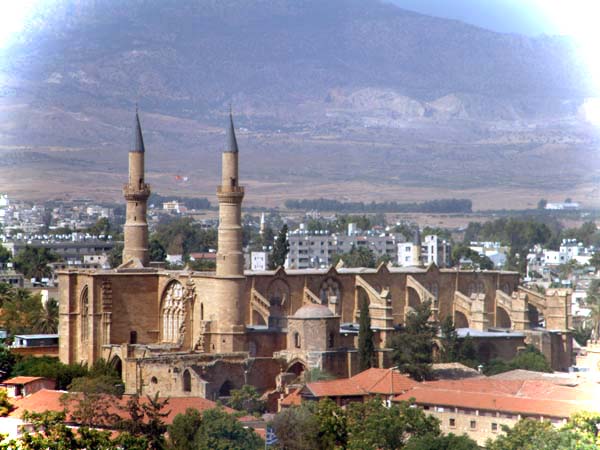Nicosia (Greek Λευκωσία - Lefkosia; tour. Lefkoşa - Lefkosha) - the capital of the Republic of Cyprus and - the northern part of the city, the so-called. North Nicosia is the capital of the partially recognized Turkish Republic of Northern Cyprus (recognized as an independent state only by Turkey).
Located in the central part of the island of Cyprus. Population - 276 thousand inhabitants (2012). The international airport has been closed since 1974 and the headquarters of the UN peacekeeping force is located here.
According to data at the end of 2004, south of the Green Line (Greek part of the city) the population is about 270 thousand inhabitants, to the north (Turkish part) 84,893 inhabitants.
Nicosia is an important commercial and industrial center. The city has 2 modern shopping malls, shops, restaurants, entertainment complexes. The city has developed textile, leather, pottery, plastics and other products, food industry. There are copper mines nearby. Nicosia has the University of Cyprus and 5 other universities.
History
Traces of the first settlers can be traced from 3900 BC. e. The city itself was founded around the XI-VII century BC. e. (named Ledra, then Lefkotheon; modern name from about the 13th century AD). It was an ancient Greek city-state. During the Hellenistic period (about 330 BC), the city lost its importance and turned into a small village. In 965, the Byzantines make the city the center of the Theme of Cyprus. In 1191, the English crusader king Richard I the Lionheart conquered the city and transferred it to Guy de Lusignan in 1192. The city becomes the capital of the Cypriot kingdom. It was during this period that the city was named Nicosia. In 1489-1571 the city was ruled by the Venetians. In 1571-1878 under the rule of the Turks. In 1878-1960 under the rule of the British. In 1960 the city became the capital of the independent Republic of Cyprus.
As a result of the invasion of Turkish troops in 1974 and the subsequent proclamation of the Turkish Republic of Northern Cyprus, the city is divided into Turkish and Greek parts. The border between them, guarded by UN troops, runs right through the historic center of the city and through the main shopping street Ledra. The northern (Turkish) part of Nicosia is the capital of the self-proclaimed TRNC and is called Lefkosa.
On April 3, 2008, work began on the dismantling of the wall dividing the city into two parts.
Lefkosa, also known as Nicosia, is the capital and largest city of Cyprus and has a special status associated with the political division of the island of Cyprus. Part of the city is under the control of the Turkish Republic of Northern Cyprus (TRNC), which has declared independence but is not recognized by the international community, with the exception of Turkey. This part of the city is known as Lefkosa (Nicosia) of Northern Cyprus. The city is located in the center of the island and is the administrative, cultural and economic center of Cyprus. Lefkosa has a rich history, it is one of the oldest cities in the world, founded about 2500 years ago.
A variety of architectural styles can be found in the city, combining elements of the ancient Greek, Roman, Byzantine, Ottoman and British periods. One of the famous sights of Lefkosa is its historical center, enclosed by a city wall from the medieval period.
The city is also known for its museums and art galleries, where you can experience the rich history and culture of Cyprus. The Cyprus Archaeological Museum and the Martial Arts Museum are located in Lefkosa and offer unique exhibits.
An important aspect of Lefkosa is the political division of the island of Cyprus into Greek and Turkish parts. The dividing line, known as the "Green Line", runs through the city, dividing it into two parts. This makes Lefkosa a unique city with a dual status, where there are various administrative and political structures.
Lefkosa is a picturesque town with cozy streets, traditional restaurants and local markets where you can experience Cypriot cuisine and culture. The hospitality of the local people makes the stay in Lefkosa pleasant and interesting for tourists.
Lefkosa Northern Cyprus is the administrative, economic and cultural center of the TRNC. In this part of the city, you can see various historical and cultural attractions, including ancient mosques, Byzantine churches, the remains of fortresses and archaeological sites.
In Lefkosa of Northern Cyprus, there are attractions such as the Selimi-i-hatun Mosque, Girneli Fortress, the Bedesten Museum, as well as an old bazaar with numerous shops and restaurants. The city also offers cultural events including festivals, concerts and exhibitions.
It is important to note that the political situation in Cyprus and the status of Lefkosa of Northern Cyprus remain contentious issues in the international community. The UN holds periodic negotiations between the Greek and Turkish sides in order to find a solution and a peaceful unification of the island.


